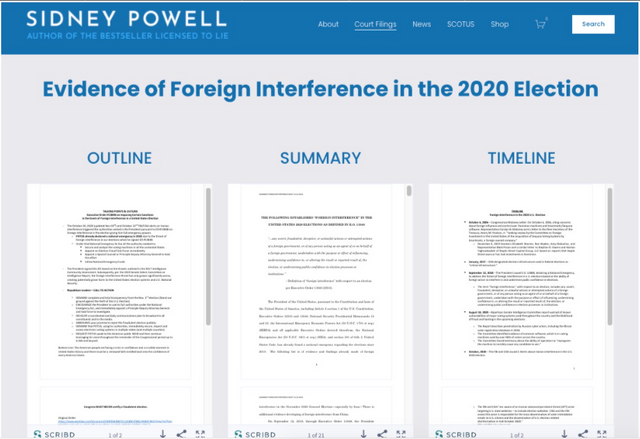 's
's
Before we get into Sidney Powell's report, whom the corporate owned media and those sold out to the globalist's agenda try to throw shade on. . .just Consider it was PROVEN here these machines could be hacked!
HOLES Exposed in Voting Systems on ABC
Professionals STATE unhackable systems Don't Exist! Interesting!
Below are some highlights from Powell’s summary report:
These election systems appear to have been intentionally and purposefully designed with inherent errors to create systemic fraud and influence election results.
The [U.S. Senate Intelligence] Committee heard disturbing testimony of the ability of operators to “reprogram the machine to invisibly cause any candidate to win.” Id. At 42. It is undisputed that the FBI and the National Security Division of the DOJ knew of these national security issues and threats.
Notably, Dominion Voting Systems do not maintain a truly auditable trail for a number of reasons, among them being that its audit logs are editable by operators (and by those with unauthorized access).
Dominion Voting Systems is owned and controlled by foreign entities. As a National Security concern, having foreign entities managing US elections gives foreign actors strategic but hidden influence upon the future of foreign policy, National Security Strategy, and National Military Strategy. Since these companies move data around the world, malign foreign states, and actors – or even opportunistic foreign states and actors – have ability to influence (or even determine) election outcomes in ways that are most favorable to their government or causes. This impacts all the elements of US National Security; Diplomacy; Information; Military; Economic; Financial; Intelligence; and Law Enforcement (DIMEFIL).
Electronic data from US elections was transmitted to Germany, Barcelona, Serbia, and Canada.
The forensic report prepared for Antrim County, Michigan found that, “the Dominion Voting System is intentionally and purposefully designed with inherent errors to create systemic fraud and influence election results”.
Dominion and Smartmatic share a physical address in Barbados despite their insistence that there is no relationship between the companies. They also have a mutual non- compete agreement detailing shared resources and code.
The fact that a Smartmatic board member, Peter Neffenberger, is named as a key member of the presidential transition team is a significant conflict of interest. Additionally, members of George Soros’ Open Society Foundations are also serving board members of Smartmatic.
Multiple expert witnesses and cyber experts identified acts of foreign interference in the election prior to November 3, 2020 and continued in the following weeks.
There is evidence of a massive cyber-attack by foreign interests on our crucial national infrastructure surrounding our election—not the least of which was the hacking of the voter registration system by Iran.
Staple Street Partners is an equity firm that owns Dominion Voting Systems.
Hootan Yaghoobzadeh is the CEO and Chairman of Staple Street Capital, which is the entity that owns Dominion. Yaghoobzadeh was a close confidant to Sadaam Hussein and worked for the Saudi Bin Laden group. He previously worked at the Carlyle Group and Cerberus Capital Management.
Since at least 2006, members of Both Parties have complained of defective voting system, especially Dominion Voting Systems.
During the time of election night and the following morning, hundreds of thousands of fraudulent votes entered the U.S. Election system. They did so in amounts, times, and sequences that mathematical and statistical experts have attested are a mathematical impossibility.
Analysis has established that there was a 5.6 % increase in votes for one candidate for president across the entire Dominion system—with all other variables frozen.
***For the 270-pages of documentation supporting her summary:
Declaration of Navid Keshavarz-Nia
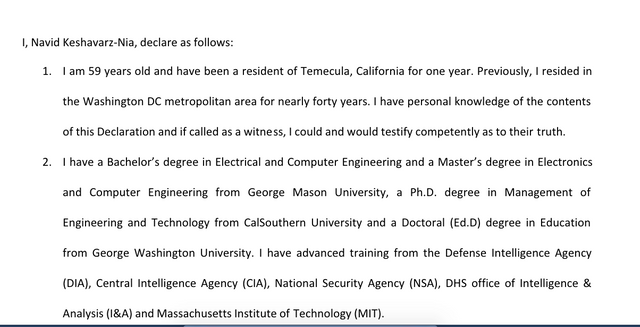
See all of Navid's affidavid here
And more info in here
https://steemit.com/stopthesteal/@artistiquejewels/what-evidence-exists-of-voter-fraud-or-as-we-must-say-it-on-censoring-platforms-ooter-odd-were-you-aware-that-german-authorities
Also see how the New York Times and others praised Navid Keshavarz-Nia for his expertise, skill set and high level of intelligence as. . .in this New York Times article of September 9, 2020
Howard Blum stated,
The following involved. . .
Alpha214 was a scam that had been “concocted” by Garrison Kenneth Courtney, 44. Mr. Courtney was “neither employed by nor otherwise affiliated with the C.I.A.,” the government’s case filings say. Mr. Courtney’s claims of support from the president and other high-level government officials were false, and many of the contracts he provided on government agency letterhead were forgeries.
In June, Mr. Courtney pleaded guilty to a single count of wire fraud and agreed to repay his victims at least $4.4 million. In a brief telephone conversation from his home in Florida this summer, Mr. Courtney referred all questions to his lawyer, Stuart Sears, who declined an interview.
Mr. Courtney was assisted by a man who sometimes went by the name Virgil Keith. In a statement Mr. Keith sent me, he said he was “duped into an elaborate scheme to defraud companies and the U.S. government by nature of meticulously scripted activities organized by Garrison Courtney.”
Over several telephone interviews, he explained, “I’m just a low- level intelligence officer, and I was taken to the D.I.A.” — the Defense Intelligence Agency — “and read onto a program I thought was a real C.I.A. op. My job was to coordinate with each company’s security office. I was conned into playing a role.” Mr. Keith has not been charged with any crime.
Alpha214 is, however, a case study of how companies in the lucrative high-tech national security business that some Beltway insiders call “espinology” try to get their share of the “Black Budget” — a compendium of classified intelligence programs that total tens of billions of dollars. It’s a legal treasure hunt where the pursuit of contracts guaranteed by taxpayer dollars is conducted by intelligence, military and procurement officials who retire from government careers to work in private enterprise.
And the case shines a clarifying spotlight on the billion-dollar no-bid, or “sole source,” contracts — contracts awarded to companies that never have to go through the rigors of competitive bidding — that are routinely awarded under the concealing shadows of national security. A 2018 study by the Center for Strategic and International Studies, a bipartisan think tank, found that the Department of Defense awarded less than half its contracts through “effective competition.”
The outlines of the con are public. But when I started digging into the case this summer, I learned more details that raise concerns about the ease with which a fake spy was able to gain access to top-secret government facilities and obtain the seemingly unwitting support of intelligence officials.
In 2014, Mr. Courtney was helping arrange the acquisition of government contracts at a Virginia tech firm, Blue Canopy, when he approached Riverside Research in Arlington, a nonprofit group funded by a nearly billion-dollar annual budget that supports hush-hush scientific and engineering work at a slew of military and intelligence agencies. (In the government filings, Riverside is referred to as “Company L.”) He offered a deal: With his insider’s knowledge and government connections, he would be able to direct lucrative no-bid contracts to Riverside.
How would Mr. Courtney make this munificent procurement dream come true? Well, he confided, he was a C.I.A. operative. He hinted that he was an NOC — an intelligence officer working under “nonofficial cover,” without the thin veil provided by, say, a diplomatic posting.
For Mr. Courtney, it was a setup that offered an opportunity. An “intensive and determined investigation” would not have revealed his ties to the C.I.A. — because there were none. It was a seemingly government-approved lie that concealed larger untruths.
Even better, Mr. Courtney, as spies say with admiration, “lived his cover.” “He walked the walk, and talked the talk,” said Ed McDonald, the chief executive of EM SURV, an information technology company that works with intelligence agencies and the Defense Department and was, he says, defrauded of more than $11 million in the scheme.
There's That Number. . .how Loved is 11?
Norman Hayes, a retired Navy rear admiral and 30-year veteran of intelligence work who was bamboozled by Mr. Courtney, told me: “He knew the jargon, had connections everywhere in government. No door seemed closed to him.” You’d need access to a highly secure video-teleconferencing system “and, no problem, he’d get access to a government facility whose name I can’t even reveal.”
In a recent article on Mr. Courtney in The Daily Beast, his high school drama teacher said, “Sometimes I think I trained him too well as an actor.” He was perfectly typecast for this role: burly, broad-shouldered and endlessly confident, a distinctly military look. In addition, Mr. Courtney would confide with an off-handed vagueness that only added to the mystery, he had done his bit during the Persian Gulf war, saying he had, according to the court filings, “hundreds of confirmed kills while in combat.”
With a showman’s flair, Mr. Courtney would layer on the tradecraft: Meetings were held in the secure SCIFs, with electronic devices confiscated to prevent eavesdropping and nondisclosure agreements required. Court filings describe him instructing the recruited contractors to take countermeasures to thwart the foreign intelligence agencies who would be, he insisted, now monitoring them.
The reality of Mr. Courtney's backstory
The reality of his back story, however, was decidedly more banal. He served in the Army, but after the gulf war was over. Following his service, and armed with a degree from the journalism school at the University of Montana, he quickly moved through a series of jobs in television: weather anchor for the CBS affiliates in Missoula, Mont., and Eugene, Ore, and then segment producer for “TMZ on TV,” the entertainment news show.
In the early 2000s, he segued into government, as a public affairs officer for the Immigration and Naturalization Service, then as a spokesman for Representative Katherine Harris, Republican of Florida, and finally settling into a four-year run, from 2005 to 2009, as a public affairs officer for the Drug Enforcement Administration.
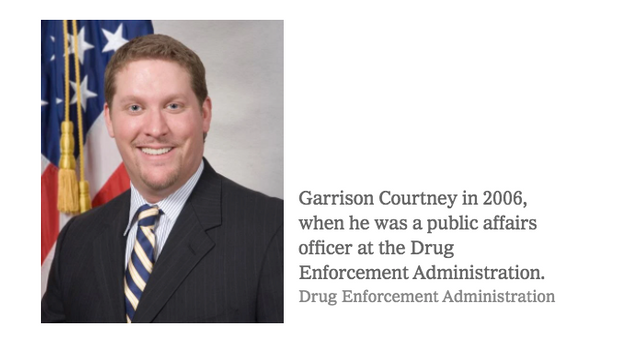
The closest Mr. Courtney had gotten to the C.I.A. was applying for a job around 2005. A conditional offer of employment had been extended, but he did not respond, and after two years the offer lapsed. As for the ricin attack, he had been hospitalized at the time he claimed he had been poisoned by a foreign hit team — for, the government sneered, “ordinary health issues.”
While Mr. Courtney was by many accounts a silky-tongued persuader, Virgil Keith was a decidedly more taciturn presence. He’s unnamed in government filings but after he was named in a civil suit by defrauded investors, he seemed to disappear; civil subpoenas could not be served. (The subpoena couldn’t be served, he told The Times, because Virgil Keith is not his real name. It’s a “work name,” he said, that he uses for government jobs.) I tried to track him down for months with no luck.
Then, one night out of the blue, he telephoned. He told a story of victimization — how he, too, had been “fooled by Courtney” and his life “ruined.” The money he made, he said, went to operational expenses, and he’s been stuck with an enormous tax bill.
Mr. Keith was also a looming and at times intimidating figure. Built like a linebacker, he had been in the Army for 20 years, in Panama, Europe and Korea in postings that, he said, involved intelligence activities. He retired as a captain and liked to think of himself as a problem solver, a can-do sort of guy.
“Do you have an elephant stuck in the weeds?” he asked in a cryptic statement he posted on the internet to drum up business for one of his many enterprises. “I can guide your elephant, eat your elephant, or shoot your elephant and bury it.”
In meetings, Mr. Courtney did the talking, and the proposal he offered Riverside was forged out of red-white-and-blue lies: In return for the institute’s providing the two operatives with commercial cover that included office space and $10,000 monthly paychecks (the stipend, Mr. Courtney explained, would be reimbursed by the C.I.A.), he would ensure that federal contracts were funneled to Riverside.
So this is Riverside approached for Virginia tech firm, Blue Canopy in need and want of these contracts.
If Riverside is. . .
- Research in Arlington
- a nonprofit group funded by a nearly billion-dollar annual budget * supports hush-hush scientific and engineering work at a slew of military and intelligence agencies. (In the government filings Riverside is referred to as “Company L.”
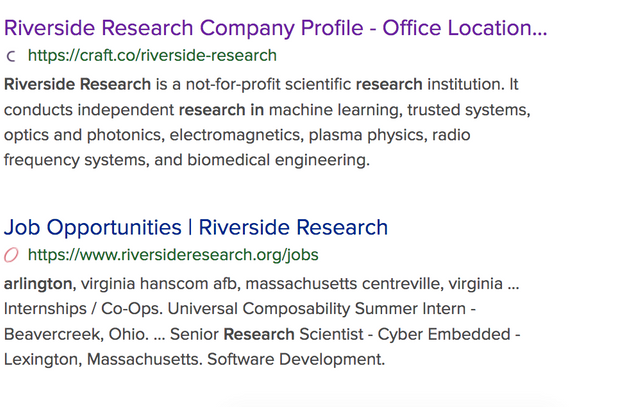
Notice their Revenue and Funding
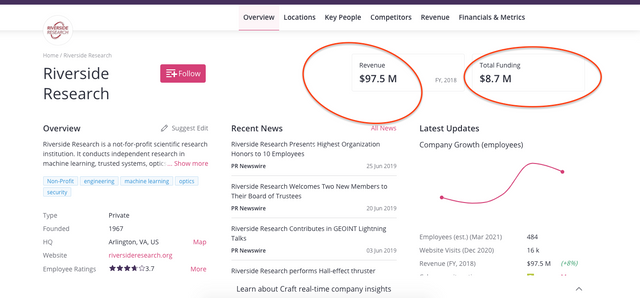
Steven Omick CEO Riverside Research
When I got my doctorate in computational electromagnetics, I went to work in the NASA community in New Mexico at White Sands Missile Range. There’s a very vibrant high-tech market in New Mexico, up and down the Rio Grande Valley, from Los Alamos to Sandia National Labs, to White Sands.
But I was working for a large company, and I got tired of that very quickly. As I looked around, there were two options: one was to go to Lockheed Martin, up in Denver, at a huge facility, and the other was to go to a company of 30 or so engineers in Tucson, Arizona. I decided I liked the idea of a small company much better.
So, I went there. I worked as an engineer for many years and grew with the company. It was a company that really valued self-starters.
I started out working as an individual contributor, but at some point, I started learning how to run programs and, as is common in our business, I progressed into roles of increasing responsibility. For the last five or six years I was there, I was the CEO. We had grown to several hundred employees. We had offices in Denver and D.C., but I got tired of traveling back and forth from Tucson to D.C. all the time.
Hold on. You went from engineer to CEO?
Yes. Opportunities come up, and if you capitalize on opportunities, that matters a lot. So, there was a contract that we decided to pursue and I volunteered to help run the proposal effort. We won the job, and I became the program manager. Over time, it became a big contract for the company. Because of that, I got a lot more exposure to customers, leadership and management, and grew from there.
I’m grateful for that. Because the opportunity was there, and I learned a ton over that period.
But at some point, that travel started getting to me, and I just decided I wanted to do something different. I came out to New Jersey to run a company that was a subsidiary of a much larger company. I ran that for a while and it was a really great company, actually. But I really wanted to get back to being a CEO.
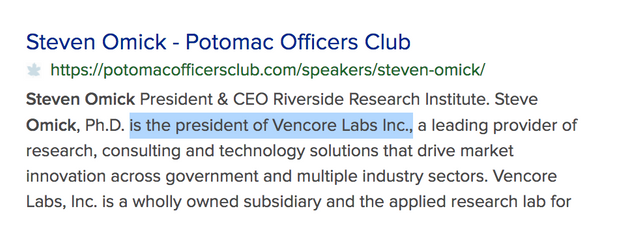
According to Potomac Officer's Club,
Vencore Labs, Inc. is a wholly owned subsidiary and the applied research lab for Vencore and provides innovations in cyber resilience, knowledge based systems, quantum computing, optics, advanced networking, smart grid, information assurance, big data and data analytics.
Prior to joining Vencore, Steve was the president and chief executive officer of Rincon Research Corporation, a provider of digital signal processing (DSP) products and engineering services for the U.S. Government Intelligence Community. An 18-year veteran of the intelligence community, Dr. Omick joined RRC in 1996 as a research engineer. Initially he was responsible for designing and developing prototype digital communications capabilities for the U.S. Government using a highly specialized signal processing development environment pioneered at RRC.
In 2011, Dr. Omick was appointed RRC’s President and CEO, where he provided leadership for the company’s 200-person workforce. He also served on
RRC’s board of directors.
Originally from Iowa City, Iowa, Steve earned his bachelor’s degree in Electrical Engineering in 1986; his master’s degree in Electrical Engineering with an emphasis on power and control systems in 1987; and his Doctorate in Electrical Engineering with an emphasis in computational electromagnetics in 1993.
Interesting!
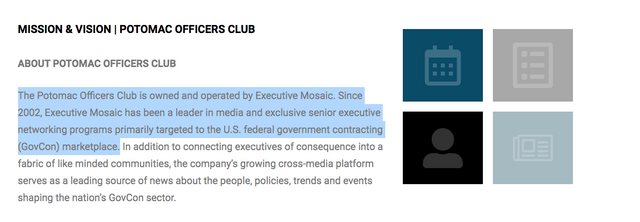
So he has been all over. ..which most would agree is needed in his position.
https://www.bizapedia.com/people/steven-omick.html
Also interesting
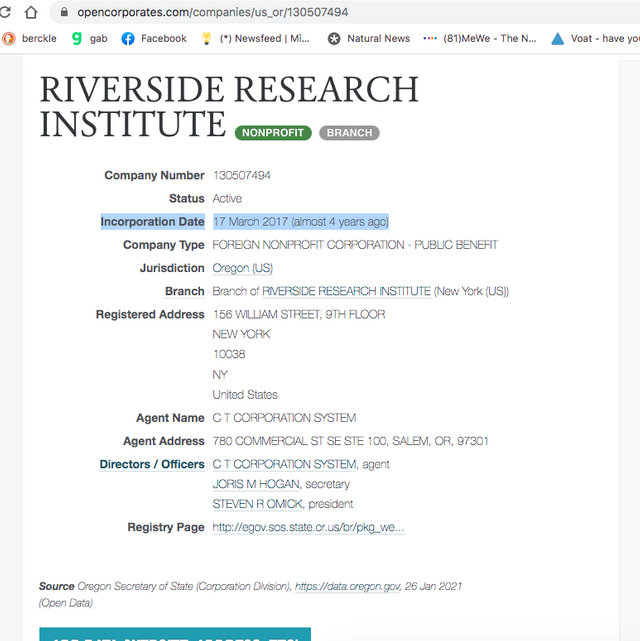
Now lets look at Blue Canopy. ..company Courtney was helping to arrange an acquisition of government contracts for as Riverside was a company Courtney spoke to and also told them he would be able to direct lucrative no-bid contracts to Riverside.
Interesting?
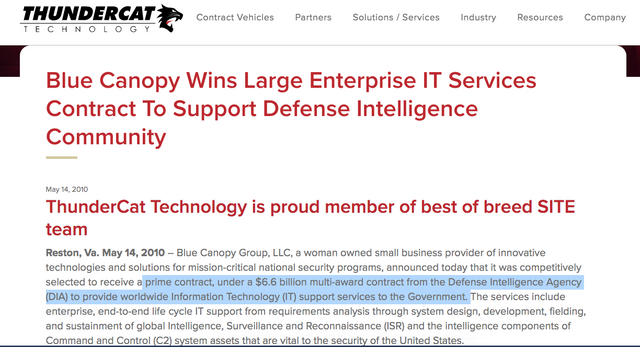
So by the time Blue Canopy received a government contract award on May 14, 2010. . .according to Thundercat they had already been doing support for DIA for at least 7 years.
Blue Canopy has supported DIA for the past seven years, and we are excited to have the opportunity to continue providing essential IT mission support to DIA and the customers serviced through the SITE vehicle,” said Blue Canopy’s President & CEO, Bradley Schwartz.
“ThunderCat brings datacenter capabilities in data storage, network security, and datacenter automation proven in the Intelligence Community.”
Blue Canopy was one of 5 small businesses that were awarded a prime contract. ThunderCat Technology, LLC, is part of the awarded Blue Canopy team.
Services from Blue Canopy included,
enterprise, end-to-end life cycle
IT support from requirements analysis through system design, development, fielding, and sustainment of global Intelligence,
Surveillance and Reconnaissance (ISR) and the intelligence components of Command and Control (C2) system assets that are vital to the security of the United States.
The SITE contract will allow Blue Canopy and its teammates including ThunderCat, Accenture, Dell Perot Systems, ManTech International Corporation, and 14 other specialty firms, to continue our long histories of providing IT services support to DIA, the Armed Services, Combatant Commands, Defense Agencies, National Command Authorities, and other Departments and Agencies with intelligence missions.
ThunderCat Technology is a Service-Disabled Veteran Owned Small Business that delivers technology services and solutions to the federal government and fortune 500 companies. Specifically, ThunderCat brings an innovative approach to solving customer problems in and around the datacenter by providing strategies for Data Storage, DR, COOP, Network Security, Modeling, WAN Optimization-Acceleration, as well as DataCenter Automation and Virtualization.
Then there is a buyout in 2017

According to Invest Jacobs,
Blue Canopy, a 2016 GovCon Contractor of the Year award winner, specializes in customized cybersecurity, data analytics and application development solutions for the Federal civilian financial, education, and healthcare sectors as well as the defense and intelligence communities. Their Security Operations Center solutions garnered top Federal Government cybersecurity program awards for the Federal Deposit Insurance Corporation (FDIC) and Centers for Medicare & Medicaid Services (CMS). Additionally, their data analytics solutions have received top awards from the Department of Homeland Security and National Science Foundation. The company has 450 employees and reported $104 million in revenue in 2016.
Jacobs Aerospace and Technology Senior Vice President Darren Kraabel.
“Blue Canopy also expands our client base into the federal civilian financial and healthcare sectors, as well as broadening our market penetration across the intelligence community. Every element of this investment supports our growth strategy,” added Kraabel.
Jacobs is one of the world’s largest and most diverse providers of full-spectrum technical, professional and construction services for industrial, commercial and government organizations globally. The company employs over 54,000 people and operates in more than 25 countries around the world. For more information, visit www.jacobs.com

So another woman owned company. . .Sentar.
Kraabel joined Jacobs in August 2002 as a senior engineer after he spent nearly a decade with the U.S. Air Force in various engineering and operational leadership positions.
Huntsville, Ala.-based Sentar offers cybersecurity products and services such as intelligence, information assurance, cyber ecosystem and research and development support.
The woman-owned company serves government clients through the U.S. Army ITES-3S, General Services Administration IT Schedule 70 and U.S. Navy SeaPort-e contract vehicles.
Sentar has offices in Huntsville, Alabama; Charleston, South Carolina; Columbia, Maryland; and San Antonio, Texas
Interesting
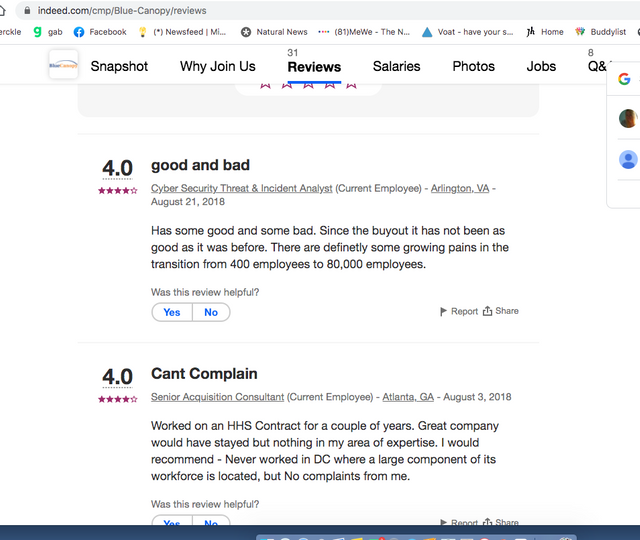


Just Some of their clients. Globalists much? You decide.
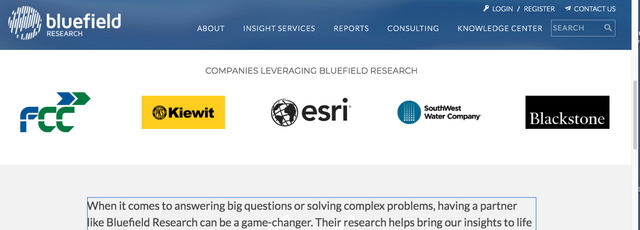
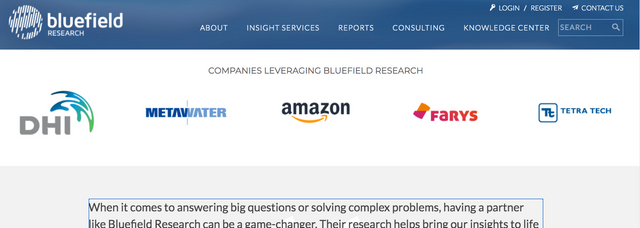
Back to Garrison Courtney
Riverside has not been accused of any wrongdoing. It did not return my calls or emails asking for comment.
However, Mr. Keith confirmed that he and Mr. Courtney were employed there. With their newly minted cover identities — a lie concealing an even bigger falsehood — legitimized by offices at Riverside, business cards, paychecks and, a particularly effective bit of theater, access to Riverside’s SCIF, the game was now afoot.
Mr. Courtney began trawling the Beltway, offering companies, with only small variations, the same deal that had landed them jobs at Riverside: In return for assisting the C.I.A. by providing them with salaries and commercial cover, the grateful agency would ensure that a windfall of governments contracts would come their corporate way.
Then Mr. Courtney came up with a new twist to the scheme — one that would bring him deeper into the corridors of legitimate power.
Consider, for telling example, the recruitment of Admiral Hayes, and his unwitting involvement in the plot.
During three decades in the upper echelons of the spy trade, Admiral Hayes had commanded the Center for Naval Intelligence, had served as director of the National Security Operations Center at the National Security Agency and had topped off his career as director of intelligence for the United States European Command. He’d been awarded a chest full of medals, including the Defense Superior Service Medal and the Legion of Merit.
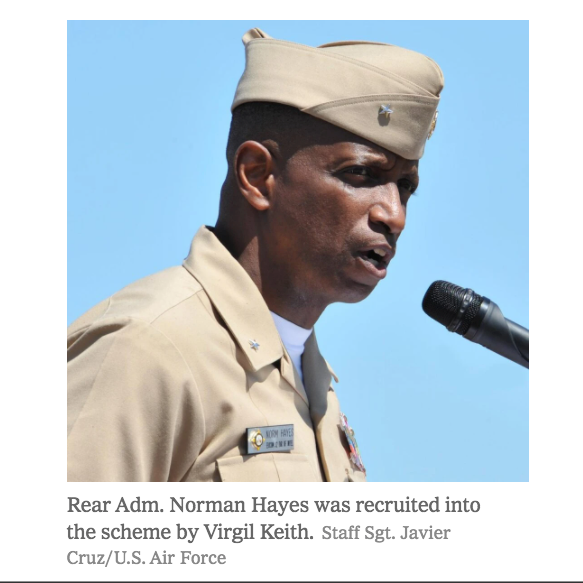
But by 2014, as Admiral Hayes recalled in our conversation, he had retired from the Navy and was employed by SBG Technology Solutions. He’d been having a business lunch in a restaurant just a stone’s throw from the Potomac when a man stopped by his table. The intruder was a stranger to the admiral, but he knew a few of his fellow diners, shook their hands, and then with a hail-fellow grin introduced himself to Admiral Hayes. “Virgil Keith,” he said.
By the time Mr. Keith had moved on, the two had exchanged cards. “We might want to do business with you,” the admiral remembered Mr. Keith saying.
Have you noticed Blue and out of the Blue is used a Lot in this story? Just wondering if you noted it?
Admiral Hayes gave little thought to the brief encounter, but for Mr. Keith it was presumably, as those in the covert world might put it, a moment of talent spotting. About 10 days later, “completely out of the blue,” recalled Admiral Hayes, “I got a call from Keith.”
“Hey, can we get together?” he asked the admiral. “I have something that may be of interest to you.”
Quickly, Mr. Keith introduced Admiral Hayes to Garrison Courtney. “They were a team, no doubt about that,” said the admiral.
Mr. Courtney outlined a business proposition: He wanted Admiral Hayes to join an association of I.T. companies that he was assembling to “go after big government contracts.” The selling point was that a consortium of companies combining different skills and expertise could, as a group, compete with the large firms like Northrop Grumman or General Dynamics.
And there was something else: “They claimed they had sources inside the government,” said Admiral Hayes. They said, “We can help you understand what the government needs.”
“I loved it,” remembered the admiral. “There are thousands of companies in D.C. competing for contracts, but if you could be part of a team you could have an advantage.” As for their “sources,” the admiral considered that “is not different than your talking to any contract guy for information inside the government.”
Reinforcing the admiral’s enthusiasm was the presence at Blue Canopy of two well-connected executives
— Michael G. Lee, a retired Air Force brigadier general, and Eric Husebo.
General Lee had been the military executive of the National Imagery and Mapping Agency, the man who helped to position the intelligence community’s secret eyes in the skies. His decorations included the Defense Superior Service Medal, the Legion of Merit and a Bronze Star.
Mr. Husebo had spent more than two decades as an I.T. executive dealing with the secret side of government acquisitions.
But after a few planning sessions, the admiral said, “everything changed.” The meetings moved to the SCIF at Riverside and phones were confiscated and nondisclosure agreements signed. With representatives from several Beltway companies in the room along with General Lee and Mr. Husebo, Mr. Courtney revealed that he was a government intelligence officer working under cover.

Their mission was a top-secret “classified action program” that, as another participant in one of the briefings recalled, “would identify companies and options that could help the government create new threat-related technology capabilities to overcome the damage” caused by Edward Snowden. No one would tell me more about the work itself — even today, the participants I spoke with are reluctant to reveal details because of national security concerns.
What exactly did Snowden do?
I have found that the story differs depending on perspective and Loyalty!
Did Snowden's reveals expose the over reach and Power of those who Never have to give an account like FIVEYES?
You decide!
Back to Dr. Navid Keshavarz-Nia
See his entire affidavit here once again,
https://www.scribd.com/document/486105599/Affidavit-of-Dr-Navid-Keshavarz-Nia-Phd#fullscreen&from_embed
Now if you continue to dive into the New York Times article you will find this. . .
The program, Mr. Courtney told them, was called Task Force Alpha214 (subsequently he’d use other code names to refer to it). In return for their participation, he assured the executives that he could share information that would give them an advantage in seeking government contracts.
Soon a flurry of contracts, some potentially worth hundreds of millions of dollars each, as well as “basic ordering agreements” (a written, negotiated understanding of terms between a firm and a government agency), and “task orders” (an outline of how the government wants its dollars spent) were delivered to the Alpha214 companies.
The well-paying agreements, according to Justice Department filings, were issued by agencies that included the Army’s Program Executive Office Enterprise Information Systems, the Department of Commerce, the C.I.A., the National Institutes of Health and the Office of the Under Secretary of Defense for Intelligence.
The documents, all on official letterheads and written in the dense bureaucratic language favored by government acquisition managers, were signed by a variety of administrators. The signatories included Glenn Nelson, Glenn Nielson, Gary Pierson, and Garrison Pierson.
The names were all aliases for Mr. Courtney, and all these contracts were fakes. They weren’t worth the paper they had been forged on.
Yet, perhaps even more alarming, other contracts were real.
A “governmentwide acquisition contract” is a mechanism to streamline the approximately $90 billion that the government annually spends on I.T. — everything from run-of-the-mill computer programs to highly classified and sophisticated communication networks.
GWACs effectively cut through red tape and tediously specific negotiations by setting longstanding requirements to guide the purchasing process. If a company can meet the terms set in a GWAC, it can bid. It’s not necessarily the winning lottery ticket, but it’s the ticket that gives you the chance to hit the jackpot.
The CRUX of it all
These acquisition contracts are largely administered by an office of the National Institutes of Health known as NITAAC, based at the Department of Health and Human Services.
Once again, Garrison Courtney went where the money was. And resourceful as always, he succeeded in melding his two schemes into one synergistic fraud.
A spokeswoman for the N.I.H. said it “does not discuss personnel matters.” [how Convenient for them!] But Justice Department filings outline the scam.
First, while employed at Riverside, Mr. Courtney went to still-unidentified officials at NITAAC and once again trotted out his concocted story that he was under cover running a highly classified program. But now he added to his narrative: The C.I.A., along with the other intelligence agencies in the task force, had decided that NITAAC should be the contracting vehicle for the program. He wanted NITAAC to assist him, the filings say, “in awarding billions of dollars’ worth of classified contracts to private companies.”
With the new surge of acquisition work his top-secret task force would be creating for NITAAC, Mr. Courtney advised, they would need to bring on additional expert staff. And he knew just the institution that could help: Riverside Research.
In fact, he argued, Riverside should be awarded this contract without the usual competitive bidding. The risk of the task force’s being revealed to enemy agents was too great. NITAAC officials, assisted by an individual that the Justice Department has identified only as “a high-ranking officer in the United States Air Force,” dutifully executed the paperwork justifying the sole-source contract.
An initial payment of at least $194,000 went to Riverside. And with the circular logic that keeps any Ponzi scheme ticking away, the money and contracts shifted from one bamboozled entity to another.
But Mr. Courtney was only getting started. In a cunning masterstroke, he used the contract with Riverside to install himself at NITAAC. Someone would need to supervise the new acquisitions personnel, and Mr. Courtney decided he’d be the best man for the job.
The fox was now sitting in the chicken coop.
As detailed in the government filings, Mr. Courtney used “sensitive, nonpublic information” he had garnered from poking around NITAAC to steer contracts to companies where he was on the payroll. And once again, Mr. Courtney succeeded in persuading public officials that, in the interests of national security, the contracts should be awarded “without full and open competition.”
But in early 2015, there were stirrings of unease in Mr. Courtney’s smoothly running con. He had never, it seemed, given much thought as to what would happen when companies, after diligently working away to fulfill their phony multimillion-dollar government contracts, demanded to get paid.
Several executives began raising loud and occasionally belligerent voices, but the Blue Canopy team was, arguably, the loudest. In May 2015, the company hired the Covington & Burling law firm to obtain the promised payment.
The two-man Covington team was made up of Herb Fenster, who since 1960 had been involved in national security issues and government contracts and who had known Mr. Courtney when he was at the Drug Enforcement Administration, and Kurt Hamrock, a younger lawyer who had done legal work on several classified military contracts and possessed a top-secret security clearance.
The two attorneys were invited to a meeting at the Riverside SCIF. In attendance were, among others, Mr. Courtney, Mr. Keith, Admiral Hayes and Eric Akers, a high-ranking official in the D.E.A.’s Office of Congressional and Public Affairs. According to Admiral Hayes, Mr. Courtney outlined in broad terms the classified action program, describing it as a multiagency program spearheaded by the drug agency. Admiral Hayes also spoke, confirming that he was a member of the task force.
The payment due Blue Canopy, the lawyers were told, “would be forthcoming.” To protect the program’s secrecy, the money would be coming out of a different office, at the Treasury.
Yet as the months passed, the explanations sent in apologetic emails to Blue Canopy and its lawyers apparently began to wear thin. Eventually, the lawyers were informed that responsibility for the program had been transferred to the National Geospatial-Intelligence Agency.
The N.G.A., which operates primarily at Fort Belvoir outside Washington in a building nearly as large as the Pentagon, “delivers,” its website proclaims with pride, “the strategic intelligence that allows the president and national policymakers to make crucial decisions on counterterrorism, weapons of mass destruction, global political crises and more.”
And in the fall of 2015, as far as the Covington lawyers knew, it had assumed operational control of Alpha214 — a classified program that didn’t exist.
VII.
And with that shift, the task force started to grow.
“My methods are effective, but I knock over rice bowls,” Eileen Preisser conceded in a 2002 interview with Signal, a magazine aimed at technology professionals working for the government and defense industries. “I’ve been called everything on Capitol Hill from Xena Warrior Princess to Joan of Arc.”
It was a bombastic reputation that Dr. Preisser had acquired in a nearly 30-year career that started in Air Force intelligence. In 1992, Dr. Preisser transferred out of active duty, later working in arms control and reconnaissance collection roles with the Defense Intelligence Agency. Her most controversial assignment was as a participant in Able Danger, a secret intelligence group that investigated terrorist schemes leading up to the Sept. 11 attacks. Dr. Preisser maintained that data mining had identified Mohamed Atta, the chief hijacker, before his mission, but that information had been ignored.
In 2015, Dr. Preisser was a special adviser to the Air Force Geospatial-Intelligence Office when she was, according to an individual familiar with Dr. Preisser’s activities, “asked to work with Courtney and Keith by two senior intelligence officials that she trusted and had worked with in the past.” She agreed to come on as the program manager.
Dr. Preisser “received absolutely nothing for working with Courtney.” He added that she had the approval of her bosses, and did the work in addition to her regular job.
With the team in place, Dr. Preisser met the Covington lawyers and, as described by a person familiar with the interaction, announced she was there to clean up the program: “She had every intention of working with Courtney and his team to pay the people who honestly worked and filed claims for payment.”
“There’s a new sheriff in town,” someone joked.
But first an email threatened to knock down the house of cards Mr. Courtney had so painstakingly constructed.
ENTER Navid Keshavarz-Nia YES Our Dr, Navid! So MSM praised him here. . .what happened to their praise when he gave a signed statement concerning the Election?**
those who worked with him said, “was always the smartest person in the room.” In doing cybersecurity and technical counterintelligence work for the C.I.A., N.S.A. and F.B.I., he had spent decades connecting top-secret dots. After several months of working with Mr. Courtney, he began connecting those dots too. He did not like where they led.
WHOA!
On Oct. 8, 2015, he sent an accusatory email to Mr. Courtney announcing that he had “voluntarily resigned from the organization.” In the memo, which was distributed to several participants in Alpha214 and later shared with me, he wrote, “It is clear that I have been deliberately deceived, lied to and criminally victimized by you based on your numerous false statements.” He called Mr. Courtney’s actions “self-serving, grossly dishonest, potentially unlawful- and surely damaging to the government’s ‘mission’ — assuming there is actually a mission to speak of.”
He also zeroed in on the money the Twins were making: “While not all of the 35-plus companies have acquiesced to your salary demands,” a “conservative estimate” put his and Mr. Keith’s annual income at $2.25 million each: “Not bad for a GS-14 salary-level employee!”
“Have you shared this information with your superiors?” he demanded.
Mr. Courtney, however, was probably not concerned about his bountiful haul being made known to his government superiors because he had none. What presumably did worry him was that Dr. Keshavarz-Nia would share his deduction with the F.B.I.
He swiftly went to work to prevent this disaster from occurring.
The Department of Justice filing states, “Courtney falsely accused an individual of being an Iranian spy after that individual publicly accused Courtney of engaging in a fraud.
The government is not revealing whom Mr. Courtney had maligned, but I, too, could connect dots. And this deduction was reinforced by another event.
Dr. Keshavarz-Nia told another person in the program that Mr. Keith showed up unexpectedly at his house to share the advice that “it would be a mistake to go off the reservation.” As Mr. Keith continued in a soft, controlled voice, he opened his jacket to reveal the gun sticking out of the waistband of his pants, this person said.
Dr. Keshavarz-Nia could not be reached, but Mr. Keith blithely explained this encounter to me. He was instructed, he said, to “go to him, do health and welfare, calm him down.” When asked if he had brandished a gun, Mr. Keith replied, “I always had a gun,” though he denied showing it off.
Pressed further, he conceded that Dr. Keshavarz-Nia was “agitated.” He said: “I was the bad guy to some people. I was aggressive, assertive. But that was just the scripted role Courtney wanted me to play.”
Interesting. . .go after the victim and Truth Teller rather than the blatant nefarious and underhanded! Typical tactics on the side of evil!
At a meeting soon after between Dr. Preisser and the two representatives from the Covington firm, a woman identified as a Department of Justice lawyer said the government would be “going after the writer of the email,” explaining that under the Intelligence Identities Protection Act, it was a federal crime to identify C.I.A. officers serving in a covert operation. There would be legal consequences for the unmasking of Mr. Courtney and Mr. Keith.
Dr. Keshavarz-Nia, however, has not been charged with any crime. While the identity of the apparent Justice Department lawyer remains buried in the secret history of the task force, what is clear is that Mr. Courtney had very effectively and very swiftly defused the threat.
But with Blue Canopy still demanding its nearly $2 million, Mr. Courtney needed a godsend. According to a civil suit filed against him and Mr. Keith, he found one in Matthew Milstead, a Beltway investor.
The government, Mr. Courtney told Mr. Milstead, was about to seize control of Blue Canopy “due to instances of malfeasance” by senior executives. “The B.C. Initiative,” the fake spy called this invented scenario.
There was, however, one obstacle that company lawyers could exploit — a payment dispute between the federal government and Blue Canopy. An outstanding bill needed to be paid or else the company could indefinitely ward off the seizure.
As outlined in the suit, he appealed to Mr. Milstead as a patriot, and as a businessman: In return for Mr. Milstead’s supplying the $1,933,500 that was owed to Blue Canopy, his investment firm, Westfields, would receive a federal contract authorizing a payment of $2,555,380 within 30 days. Mr. Courtney was dangling a month’s profit of about $600,000 — and, best of all, the money would be contractually guaranteed by the United States of America.
It was a deal too good to turn down. And as things turned out, too good to be true.
With Mr. Milstead’s help, Tim Clark, the co-founder of Capefirst Funding, quickly put together a consortium of investors, and Mr. Milstead signed the contract about a week later in the Riverside SCIF. With Mr. Courtney and Mr. Keith watching, a man representing himself as a government contracting officer executed the agreement, which, according to the civil suit, bore Department of Defense identifiers and inscriptions. Mr. Milstead was not allowed to retain a copy of the contract because, Mr. Courtney explained, his company did not possess a “facility clearance,” necessary for a safe used to store classified documents.
But Mr. Milstead’s cautious investors at Capefirst were not prepared to release the $1.9 million without seeing a written government contract.
Mr. Keith and Mr. Milstead met again and Mr. Keith delivered to Mr. Milstead an unclassified “notification of award.” It was again written on Defense Department stationery and specified the amount to be paid: $2,555,380. It was, the suit says, signed by a contracting officer named Glenn Nelson — a Courtney alias.
The money was wired to an escrow account in Tysons Corner, Va., and then routed on to Blue Canopy. It was November 2015, and the company had at last been paid in full for some of its 2014 work.
As a result of an out-of-court settlement in the civil suit, Blue Canopy (now owned by Jacobs Engineering Group) would repay the $1.9 million it had received. Mr. Courtney and Mr. Keith, however, still remain defendants in this action.
But at the time, one mark had paid off another. And the scheme would live on for another prosperous day.
A new year, however, brought back old invoices. The Covington lawyers were soon demanding that Blue Canopy be paid the seven-figure sum due for work it had performed in 2015. Mr. Fenster reached out to some Justice Department officials he knew, asking if they could give him any background insight on Mr. Courtney. The officials said they’d investigate and get back to him.
In May 2016, Mr. Fenster’s phone rang. It was the deputy assistant attorney general for intelligence. He informed the stunned lawyer that the government was investigating the entire program. Apparently, the investigation had begun the previous year.
Teams of investigators from the F.B.I., the C.I.A., the Intelligence Community Inspector General’s office, the N.G.A., the Air Force, the Army, the Defense Department, the Justice Department, the Department of Health and Human Services, the Naval Criminal Investigative Service, and four assistant U.S. attorneys built their case. And when they had tied up the loose ends, they wound up indicting a single individual — Garrison Courtney.
Maybe investigators are still pursuing other angles. But for now, as for all the other troubling aspects of the wide-reaching affair — the access to secure government facilities, the well-paying jobs unreasonably doled out, the helpful intervention of a Justice Department lawyer, the participation, however unwitting, of a high-flying group of current and former intelligence officials whose fundamental job was to figure out what’s going on so that the nation can be kept safe — the government was apparently willing to shrug its shoulders and move on.
Yet, one question hovers over the entire astounding enterprise: How did it last as long as it did?
One insight can perhaps be gleaned from a genuine spy. Victor Cherkashin, the Russian intelligence officer who “ran” Aldrich Ames, the mole burrowed inside the C.I.A., wrote: “Intelligence officers might think they’re chiefly responsible for recruiting agents, but most of the work really consists of finding people who want to be recruited.”
And that’s what Garrison Courtney did. He targeted companies that were looking for an edge, a legitimate advantage that would give them access to what was going on behind closed government doors. And if, in the interests of a very broadly defined national security, a deal was dangled without competitive bidding, they could solemnly contend that they were simply doing their patriotic duty.
Beltway companies that were already avidly recruiting former high-ranking military officials and government procurement officers to help guide them through the multibillion-dollar federal marketplace were primed by experience, instinct and greed to accept Mr. Courtney’s inflated, if not preposterous, stories.
A similar sort of self-interest might have motivated the investors who handed over nearly $2 million. The prospect of a $600,000 profit in a month — about a 30 percent return — conceivably helped dull common sense.
Yet what about the military and intelligence officials who fell for the fraudulent operation?
And how it Generally Works!
One transactional explanation can perhaps be found in the government’s filing. It identifies a “public official” who was “employed as a civilian with a branch of the United States military.” Mr. Courtney “sought corruptly to influence” this official by providing “things of value.” These included persuading two companies in the program to hire the official’s adult child, “notwithstanding that the adult child lacked relevant training or experience.”
Another, more nuanced answer might be found in the way life is lived in this highly compartmentalized secret world. It’s full of people who proudly feel they know so much, only they can’t ever talk about it. It’s not just that these professionals can’t share what they know; they can’t admit even knowing it.
The reality IS. . .they enjoy their position on the Totem Pole both of superiority and keeping their pay check!
**Sources and connecting Reports/Articles
Full Interview on Charlie Rose Trump 1992
https://www.bloomberg.com/news/videos/2017-02-21/1992-conversation-with-donald-trump-charlie-rose
OOTER ODD AND THE KRAKEN
https://www.bitchute.com/video/RMQMjbbQIFYc/
https://washingtonexec.com/2019/03/riverside-research-steve-omick-stem/
https://potomacofficersclub.com/speakers/steven-omick/
https://csis.gmu.edu/IICPS-2015/index.html
https://uploads1.craft.co/uploads/pnl_source/document/308806/750de084e1031be3.pdf
https://www.appliedres.com/copy-of-about
https://www.zacks.com/stock/news/274327/jacobs-jec-blue-canopy-buyout-to-stoke-inorganic-growth
https://www.thundercattech.com/press-releases/blue-canopy-partnership/
https://www.businesswire.com/news/home/20170831006410/en/
https://www.indeed.com/cmp/Blue-Canopy/reviews
https://www.bluefieldresearch.com/co/blue-canopy/
https://www.govconwire.com/2019/09/jacobs-vet-darren-kraabel-joins-sentar-as-president/
https://craft.co/riverside-research/executives
Facebook Frames latest drop Kevin Clinesmith and others involved Explained!
Now why do you suppose the #Traitors have been branded as such? You know why.
What were they desperately trying to hide?
Evidence provided and Fully Sourced throughout the frame photos.
https://www.facebook.com/melissa.mcgarity.14/posts/10221767992363545
Numerous Group pages disappeared and were removed dealing with a certain "Movement" President Trump was asked about in a Key Presser from August 19, 2020.
Ask yourself WHY?
Do you censor and destroy those who are Not a Threat?
Or do you target those who stand to Expose what you are truly up to?
https://www.facebook.com/melissa.mcgarity.14/posts/10221782047194907
John Perry Barlow FB Frames
https://www.facebook.com/melissa.mcgarity.14/posts/10221309415699415
Corona Satellites Facebook Frames
There is a Great Deal involved with this frames and numerous connections.
Including the reminder that Melinda Gate's father was an aerospace engineer.
He worked on Apollo missions
https://www.facebook.com/melissa.mcgarity.14/posts/10221171425609749
https://www.nytimes.com/2020/09/09/opinion/sunday/garrison-courtney-spies-contracts.html
https://qanonpress.wordpress.com/2019/03/19/rule-no-9-and-the-mike-pence-envelope/
https://www.courtlistener.com/recap/gov.uscourts.mied.350905/gov.uscourts.mied.350905.1.19.pdf